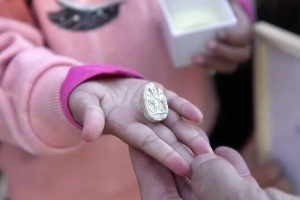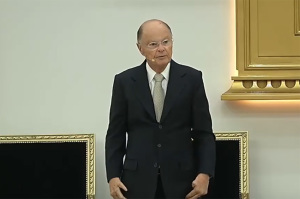Archaeological Discovery: Rare 4th Century Pottery With Christian Symbol Found in London

A shard of pottery discovered in modern-day London, England, provides an interesting view into early Christian settlements in Europe, archaeologists say.
The pottery, which was discovered in 1970 near Brentford High Street in London, was recently flagged as showing a depiction of the chi rho, a Christian symbol showing the first two Greek letters of "Khristos," or "Christ."
The important religous writing on the artifact had been previously overlooked by archaeologists.
The pottery fragment, which will go on display beginning this Easter weekend at the Museum of London, was discovered in what was likely a 4th century Christian community near the River Thames in Roman London.
Adam Corsini, who serves as the Archaeology Collections Manager for Museum of London Archaeology, told The Guardian that the newly-revealed find shed light on Christianity in Europe during the 4th century.
"Although we can't say from one object that Roman London and its hinterland were practicing Christianity, it does suggest that Christians were at least present at some point in 4th-century Roman Brentford," Corsini said. "Christian symbols from the Roman period are rare, especially from sites within Londinium's surrounding hinterland, and there are only a few examples in our collections relating to London."
Corsini added to Culture 24 that his team of excavators was lucky to spot the Christian symbol on the pottery shard while sifting through materials that had been excavated decades earlier.
"At first we noticed there was some sort of mark on the pot and then quickly realized the significance of what we had," the collector said.
Along with the pottery shards, archaeologists have found several other important artifacts at the Brentford High Street site, including coins, jewelry and bronze bowls, among other treasures.
There have been other important Christian finds in England and the rest of Europe in recent months, including the discovery of hidden writing on a Bible dating back to 1535 that was published by King Henry VIII's printer.
The mysterious writing provides insight into the process of the Protestant Reformation, historians say.
Eyal Poleg, historian for the Queen Mary University of London, explained that the secret writing, which had been covered by paper, indicates that the Protestant Reformation was not an easy, smooth transition.
"Until recently, it was widely assumed that the Reformation caused a complete break, a Rubicon moment when people stopped being Catholics and accepted Protestantism, rejected saints, and replaced Latin with English. This Bible is a unique witness to a time when the conservative Latin and the reformist English were used together, showing that the Reformation was a slow, complex, and gradual process," he said.
In March 2012, archaeologists also discovered one of the oldest Christian burial sites in Great Britain in a village outside of Cambridge, dating back between 650 and 680 AD.
The discovery included a grave for a teenage girl, along with a large gold cross pendant that was likely placed over her chest during the burial process.
Dr Sam Lucy, who specializes in England's Anglo Saxon burial proceedings at Newnham College, Cambridge, said in 2012 that the girl's elaborate burial is evidence that she was likely royalty.
"To be buried in this elaborate way with such a valuable artefact tells us that this girl was undoubtedly high status, probably nobility or even royalty. This cross is the kind of material culture that was in circulation at the highest level of society. The best known example of the pectoral cross was that found in the coffin of St Cuthbert now in Durham Cathedral," he said.





























